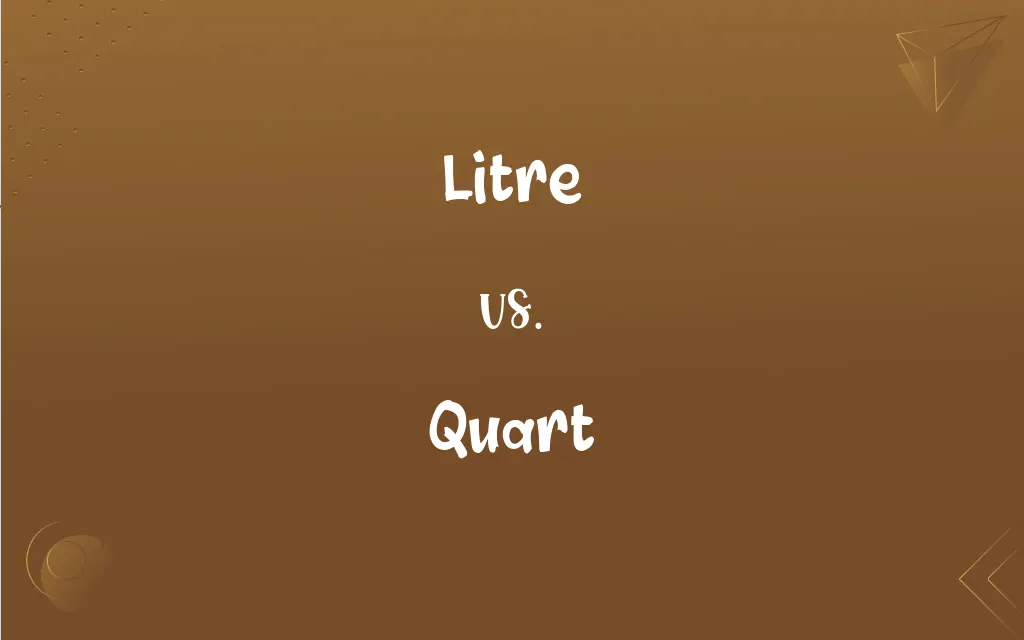Litre vs. Quart: What's the Difference?
Edited by Aimie Carlson || By Janet White || Updated on March 4, 2024
A litre is a metric unit of volume equal to 1,000 cubic centimeters, used worldwide, while a quart is an imperial unit of volume, smaller than a litre, used primarily in the U.S.

Key Differences
The litre (spelled "liter" in American English) is a unit of volume in the metric system, widely used around the world for measuring liquids and other substances. One litre is defined as the volume of one cubic decimeter (1,000 cubic centimeters) or one kilogram of water at maximum density and a specific temperature. This makes it a convenient unit for many scientific and everyday measurements. The quart, on the other hand, is used primarily in the United States as part of the U.S. customary system. It is smaller than a litre, with one U.S. liquid quart equal to approximately 0.946353 litres. The U.S. also has a dry quart, which is used to measure dry commodities and is equivalent to approximately 1.101221 liters.
While both the litre and the quart are used to measure volume, their usage reflects different measurement systems. The litre's widespread acceptance in scientific and international contexts is due to its inclusion in the metric system, which is standardized and used globally. In contrast, the quart, as part of the U.S. customary and Imperial systems, is more commonly used in everyday life in countries like the United States for measuring volumes of liquids such as milk and gasoline.
The choice between using litres and quarts depends on regional conventions, the system of measurement in use, and the specific context of the measurement. For example, automotive engine displacements are typically measured in litres worldwide, including in the U.S., while many everyday liquid volumes in the U.S. are still measured in quarts.
Comparison Chart
System
Metric
U.S. Customary, Imperial
Volume
1,000 cubic centimeters (1 cubic decimeter)
U.S.: 0.946353 liters, Imperial: 1.13652 liters
ADVERTISEMENT
Usage
Worldwide for scientific and general measurements
Primarily in the U.S. for everyday measurements
Water Weight
Equivalent to 1 kilogram at maximum density
Varies, less than 1 kilogram
Common Measurements
Beverages, fuel, engine displacements
Beverages, cooking ingredients in the U.S.
Conversion
N/A
1 U.S. quart ≈ 0.946353 L, 1 Imperial quart ≈ 1.13652 L
Litre and Quart Definitions
Litre
A metric unit of volume equal to 1,000 cubic centimeters.
The car has a fuel efficiency of 5 litres per 100 kilometers.
ADVERTISEMENT
Quart
Divided into two types: liquid and dry in the U.S.
The recipe calls for a quart of dry oats.
Litre
Used globally for scientific and everyday measurements.
She bought a 2-litre bottle of soda.
Quart
Reflects regional measurement preferences.
Gasoline is sold by the gallon, but engine oil is often measured in quarts in the U.S.
Litre
Convenient for measuring liquid and solid volumes.
The container can hold up to 20 litres of water.
Quart
Smaller than a litre, used for everyday measurements in the U.S.
The engine oil comes in quart-sized containers.
Litre
Standard in automotive engine displacements.
The new model features a 3.5-litre V6 engine.
Quart
A unit of volume in the U.S. customary and Imperial systems.
He added a quart of milk to the recipe.
Litre
Variant of liter.
Quart
A unit of volume or capacity in the US Customary System, used in liquid measure, equal to 1/4 gallon or 32 ounces (0.946 liter).
Litre
The metric unit of fluid measure, equal to one cubic decimetre. Symbols: l, L, ℓ
You should be able to fill four cups with one litre of water.
Quart
A unit of volume or capacity in the US Customary System, used in dry measure, equal to 1/8 peck or 2 pints (1.101 liters).
Litre
(informal) A measure of volume equivalent to a litre.
Quart
A unit of volume or capacity in the British Imperial System, used in liquid and dry measure, equal to 1.201 US liquid quarts or 1.032 US dry quarts (1.136 liters). See Table at measurement.
Litre
Same as Liter.
Quart
A container having a capacity of one quart.
Litre
A metric unit of capacity equal to the volume of 1 kilogram of pure water at 4 degrees centigrade and 760 mm of mercury (or approximately 1.76 pints)
Quart
The contents of such a container.
Litre
Essential in lab settings for precise volume measurements.
The experiment required 500 millilitres (0.5 litre) of solution.
Quart
A unit of liquid capacity equal to two pints; one-fourth (quarter) of a gallon. Equivalent to 1.136 liters in the UK and 0.946 liter (liquid quart) or 1.101 liters (dry quart) in the U.S.
Quart
(cards) Four successive cards of the same suit.
Quart
(obsolete) A fourth; a quarter; hence, a region of the earth.
Quart
The fourth part; a quarter; hence, a region of the earth.
Camber did possess the western quart.
Quart
A measure of capacity, both in dry and in liquid measure; the fourth part of a gallon; the eighth part of a peck; two pints.
Quart
A vessel or measure containing a quart.
Quart
In cards, four successive cards of the same suit. Cf. Tierce, 4.
Quart
A United States liquid unit equal to 32 fluid ounces; four quarts equal one gallon
Quart
A British imperial capacity measure (liquid or dry) equal to 2 pints or 1.136 liters
Quart
A United States dry unit equal to 2 pints or 67.2 cubic inches
Quart
Common in cooking and liquid commodity transactions.
She bought a quart of ice cream for dessert.
FAQs
What is a litre?
A litre is a unit of volume in the metric system, equivalent to 1,000 cubic centimeters, used worldwide for various measurements.
How do I know whether to use litres or quarts in recipes?
The choice between litres and quarts in recipes depends on the measurement system commonly used in your country or the specific cookbook or culinary guide you are following.
Why are engine displacements usually measured in litres?
Engine displacements are measured in litres to provide a standardized, globally recognized unit of measurement that facilitates comparison and classification of engines across different countries and manufacturers.
Are quarts used outside of the United States?
While the quart is primarily used in the United States, the Imperial quart is also known in other countries that have historical ties to the British Imperial system, but its use is more limited compared to litres.
Can I convert quarts to litres easily?
Yes, you can convert quarts to litres by multiplying the number of quarts by 0.946353 for U.S. quarts or by 1.13652 for Imperial quarts to get the equivalent in litres.
Is there a significant difference in volume between a litre and a quart?
While the difference may seem small for individual measurements, it can become significant in larger quantities, affecting recipes, fuel efficiency calculations, and other applications.
How are dry and liquid quarts different?
In the U.S. customary system, dry and liquid quarts measure different volumes, with the dry quart being larger (approximately 1.101221 litres) than the liquid quart (approximately 0.946353 litres), reflecting their use for dry commodities and liquids, respectively.
How has the usage of litres and quarts evolved over time?
The usage of litres, part of the metric system, has become more widespread globally, reflecting a shift towards standardization. Quarts, while still used in the U.S. and for specific purposes in other countries, represent older measurement systems.
When would I use litres instead of quarts?
Litres are used in contexts and regions that adopt the metric system for scientific, automotive, and everyday measurements, whereas quarts are used primarily in the U.S. for specific everyday measurements.
Why is the litre considered a preferred unit in scientific measurements?
The litre is preferred in scientific measurements due to its compatibility with the metric system, which is internationally recognized for its ease of conversion and use in calculations.
How does a quart compare to a litre?
A quart is smaller than a litre, with one U.S. liquid quart equal to approximately 0.946353 litres, and one Imperial quart equal to about 1.13652 litres.
How do educational systems in various countries approach teaching litres and quarts?
Educational systems in countries using the metric system emphasize litres, while those in the U.S. may teach both, reflecting their usage in daily life and the importance of understanding both systems for global competence.
Can the use of litres and quarts affect international trade?
Yes, differences in measuring systems can affect international trade, requiring conversions between litres and quarts for accuracy in quantities and pricing, especially in industries like food and beverages, and oil.
What role do litres and quarts play in home brewing and winemaking?
Litres and quarts are crucial in home brewing and winemaking for measuring ingredients, liquids, and final product volumes, with the choice of unit often depending on the country and personal preference.
What are the environmental implications of using litres vs. quarts for packaging?
While the unit of measurement itself (litres vs. quarts) does not directly impact the environment, the choice can affect packaging design, efficiency, and waste, especially if products are tailored to specific markets with different measurement preferences.
How do digital platforms handle conversions between litres and quarts?
Digital platforms, such as online calculators and mobile apps, offer tools for quickly converting between litres and quarts, facilitating international recipes, travel, and commerce.
What are some everyday items measured in quarts?
Everyday items measured in quarts include liquids like milk, juice, and engine oil in the U.S., highlighting the unit's use in everyday life and specific industries.
Are there any legal implications in using litres instead of quarts or vice versa?
In countries with strict labeling laws, using the correct unit of measurement (litres or quarts) on products is essential for compliance, affecting labeling, marketing, and sale of goods.
How can understanding litres and quarts benefit consumers?
Understanding both litres and quarts allows consumers to compare prices, understand product volumes, and make informed decisions in both domestic and international contexts.
What future trends might affect the use of litres and quarts?
Future trends, such as increased global trade and efforts towards standardization, may lead to a broader adoption of the metric system and litres, potentially decreasing the everyday use of quarts in favor of a more unified measurement system.
About Author
Written by
Janet WhiteJanet White has been an esteemed writer and blogger for Difference Wiki. Holding a Master's degree in Science and Medical Journalism from the prestigious Boston University, she has consistently demonstrated her expertise and passion for her field. When she's not immersed in her work, Janet relishes her time exercising, delving into a good book, and cherishing moments with friends and family.
Edited by
Aimie CarlsonAimie Carlson, holding a master's degree in English literature, is a fervent English language enthusiast. She lends her writing talents to Difference Wiki, a prominent website that specializes in comparisons, offering readers insightful analyses that both captivate and inform.































































